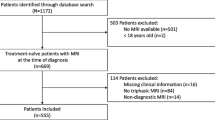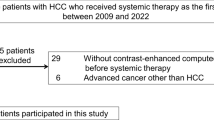Abstract
Objectives
To validate and reappraise the Assessment for Retreatment with Transarterial chemoembolization (ART) score comprising three parameters (>25 % increase in aspartate aminotransferase [AST], increase in Child-Pugh score and tumour response), determined prior to subsequent transarterial chemoembolization (TACE).
Methods
Enrolled patients were diagnosed with unresectable non-metastatic hepatocellular carcinoma and underwent multiple TACEs between June 2006 and December 2007 (N = 153). Subgroupings were classified according to the established cut-off (≤1.5 vs. ≥2.5). Survival analysis using the Kaplan-Meier curve was performed.
Results
The original ART score dichotomized patients according to their overall survival (P = 0.004). We found several patients who actually survived longer than others were assigned to a poor prognostic group due to the AST component. Parameter estimates for AST obtained from our analysis were much lower than the original version (0.5 vs. 2.1). We adjusted the component according to the value of our parameter estimates, and patients with >25 % AST increase received 1.0 point. After this modification, patients assigned to the favourable prognostic group were more likely to have a better survival outcome (median 23.9 vs. 12.2 months, P < 0.001).
Conclusions
In hepatitis B virus-endemic regions, the ART score is valid and can better predict post-TACE survival after the AST component is modified.
Key Points
• The ART score was validated in a HBV-endemic region.
• The modified ART score improved prognostic performance by reappraising the AST component.
• The modified ART score helps physicians make decisions for further TACE.





Similar content being viewed by others
Abbreviations
- HCC:
-
hepatocellular carcinoma
- BCLC:
-
Barcelona clinic liver cancer
- TACE:
-
transarterial chemoembolization
- ART:
-
Assessment for retreatment with transarterial chemoembolization
- AST:
-
aspartate aminotransferase
- OS:
-
overall survival
- EASL:
-
European Association for the Study of Liver
- HBV:
-
hepatitis B virus
- CT:
-
computed tomography
- AFP:
-
alpha-fetoprotein
- HR:
-
hazard ratio
- NRI:
-
net reclassification improvement
- CI:
-
confidence interval
- SD:
-
standard deviation
- DEB:
-
drug-eluting bead
References
Bolondi L, Burroughs A, Dufour JF, Galle PR, Mazzaferro V, Piscaglia F et al (2012) Heterogeneity of patients with intermediate (BCLC B) Hepatocellular Carcinoma: proposal for a subclassification to facilitate treatment decisions. Semin Liver Dis 32:348–359
de Lope CR, Tremosini S, Forner A, Reig M, Bruix J (2012) Management of HCC. J Hepatol 56:S75–S87
Bruix J, Sherman M (2011) Management of hepatocellular carcinoma: an update. Hepatology 53:1020–1022
Dufour JF, Bargellini I, De Maria N, De Simone P, Goulis I, Marinho RT (2013) Intermediate hepatocellular carcinoma: current treatments and future perspectives. Ann Oncol 24:ii24–ii29
Kim do Y, Han KH (2012) How to improve treatment outcomes for hepatocellular carcinoma of intermediate and advanced stage. Dig Dis 30:598–602
Llovet JM, Bru C, Bruix J (1999) Prognosis of hepatocellular carcinoma: the BCLC staging classification. Semin Liver Dis 19:329–338
Bruix J, Sherman M (2005) Management of hepatocellular carcinoma. Hepatology 42:1208–1236
Takayasu K (2013) Transcatheter arterial chemoembolization for unresectable hepatocellular carcinoma: recent progression and perspective. Oncology 84:28–33
Cheng AL, Amarapurkar D, Chao Y, Chen PJ, Geschwind JF, Goh KL et al (2014) Re-evaluating transarterial chemoembolization for the treatment of Hepatocellular Carcinoma: consensus recommendations and review by an international expert panel. Liver Int 34:174–183
Sieghart W, Hucke F, Pinter M, Graziadei I, Vogel W, Muller C et al (2013) The ART of decision making: retreatment with transarterial chemoembolization in patients with hepatocellular carcinoma. Hepatology 57:2261–2273
Hucke F, Sieghart W, Pinter M, Graziadei I, Vogel W, Muller C et al (2014) The ART-strategy: Sequential assessment of the ART score predicts outcome of patients with hepatocellular carcinoma re-treated with TACE. J Hepatol 60:118–126
Contal C, O'Quigley J (1999) An application of changepoint methods in studying the effect of age on survival in breast cancer. Comput Stat Data Anal 30:253–270
Cook NR, Ridker PM (2009) Advances in measuring the effect of individual predictors of cardiovascular risk: the role of reclassification measures. Ann Intern Med 150:795–802
Sobin LH, Gospodarowicz MK, Wittekind C (2011) TNM classification of malignant tumours, John Wiley & Sons
Williams B, Mandrekar J, Mandrekar S, Cha S, Furth A (2006) Technical report series No. 79, finding optimal cutpoints for continuous covariates with binary and time-to-event outcomes, department of health sciences research. Mayo Clinic, Rochester
Llovet JM, Burroughs A, Bruix J (2003) Hepatocellular carcinoma. Lancet 362:1907–1917
Brechot C, Gozuacik D, Murakami Y, Paterlini-Brechot P (2000) Molecular bases for the development of hepatitis B virus (HBV)-related hepatocellular carcinoma (HCC). Semin Cancer Biol 10:211–231
Acknowledgments
The scientific guarantor of this publication is Dr. Han Chu Lee. The authors of this manuscript declare no relationships with any companies whose products or services may be related to the subject matter of the article. The authors state that this work has not received any funding. One of the authors (Jung Bok Lee) has significant statistical expertise. Institutional Review Board approval was obtained.
Written informed consent was waived by the Institutional Review Board. Methodology: retrospective, diagnostic or prognostic study, performed at one institution.
Author information
Authors and Affiliations
Corresponding author
Ethics declarations
Conflicts of interest and source of funding
None to declare.
Rights and permissions
About this article
Cite this article
Ha, Y., Lee, J.B., Shim, J.H. et al. Validation and reappraisal of the assessment for retreatment with transarterial chemoembolization score for unresectable non-metastatic hepatocellular carcinoma in a hepatitis b virus-endemic region. Eur Radiol 26, 3510–3518 (2016). https://doi.org/10.1007/s00330-015-4185-2
Received:
Revised:
Accepted:
Published:
Issue Date:
DOI: https://doi.org/10.1007/s00330-015-4185-2




